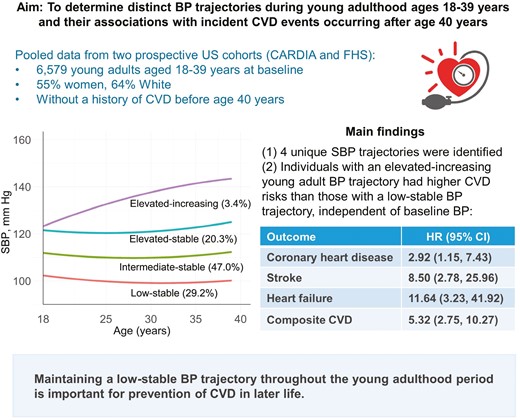-
Views
-
Cite
Cite
Mengying Xia, Jaejin An, Heidi Fischer, Norrina B Allen, Vanessa Xanthakis, Yiyi Zhang, Blood Pressure Trajectories During Young Adulthood and Cardiovascular Events in Later Life, American Journal of Hypertension, Volume 38, Issue 1, January 2025, Pages 38–45, https://doi.org/10.1093/ajh/hpae126
Close - Share Icon Share
Abstract
Studying the association between blood pressure (BP) trajectories during young adulthood and subsequent cardiovascular disease (CVD) risk can provide insights into how long-term BP patterns in early-life influence the development of CVD later in life.
We pooled data from 2 US cohorts (Coronary Artery Risk Development in Young Adults, Framingham Heart Study). We used latent growth curve models to identify distinct BP trajectory groups between ages 18 and 39 years. We then used Cox proportional hazards models to assess the associations between BP trajectories and CVD events (composite of coronary heart disease [CHD], stroke, and heart failure [HF]) after age 40 years.
We included 6,579 participants and identified 4 distinct systolic BP (SBP) trajectory groups during young adulthood. During a median follow-up of 18.2 years after age 40 years, 213 CHD, 139 stroke, 120 HF, and 400 composite CVD events occurred. Individuals in an elevated-increasing vs. low-stable SBP trajectory during young adulthood were associated with a higher risk of CVD after adjusting for traditional CVD risk factors, with hazard ratios (95% confidence interval) of 3.25 (1.63, 6.46) for CHD, 3.92 (1.63, 9.43) for stroke, 8.30 (2.97, 23.17) for HF, and 3.91 (2.38, 6.41) for composite CVD outcomes. Adding BP trajectory to BP at baseline improved model discrimination for all outcomes (changes in Harrell’s C-index 0.0084–0.0192).
An elevated-increasing BP trajectory during young adulthood is associated with a higher risk of CVD later in life, highlighting the importance of maintaining a low-stable BP trajectory throughout the young adulthood period for prevention of CVD in later life.





